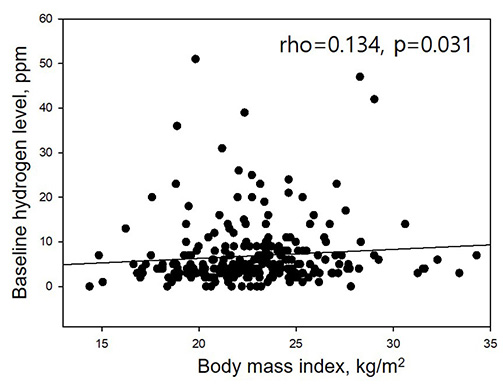Korean J Gastroenterol.
2020 Jan;75(1):23-28. 10.4166/kjg.2020.75.1.23.
Influencing Factors on Lactulose Breath Test Results
- Affiliations
-
- 1Division of Gastroenterology, Department of Internal Medicine, Chonnam National University Medical School, Gwangju, Korea. jsrew@jnu.ac.kr
- 2Division of Endocrinology, Department of Internal Medicine, Chonnam National University Medical School, Gwangju, Korea.
- KMID: 2471136
- DOI: http://doi.org/10.4166/kjg.2020.75.1.23
Abstract
- BACKGROUND/AIMS
This study aimed to identify the demographic and clinical factors associated with positive breath-test results and to assess the relationship between hydrogen and methane production in patients with suspected irritable bowel syndrome (IBS).
METHODS
The demographic and clinical factors of 268 patients with suspected IBS, who had undergone a lactulose breath test, were analyzed.
RESULTS
Of 268 patients included in this study, 143 (53.4%) were females. The median age and BMI of the patients was 58.0 years (range, 18.0-80.0 years) and 22.5 kg/m² (range, 14.4-34.3 kg/m²), respectively. A weak positive correlation was observed between the BMI and baseline hydrogen level (rho=0.134, p=0.031). Women were significantly more likely to show a ≥20 ppm increase in hydrogen within 90 min (early hydrogen increase, p=0.049), a ≥10 ppm increase in methane within 90 min (early methane increase, p=0.001), and a ≥10 ppm increase in methane between 90 min and 180 min (late methane increase, p=0.002) compared to men. The baseline hydrogen level was related to the baseline methane level (rho=0.592, p<0.001) and the maximal hydrogen level within 90 min was related to maximal methane level within 90 min (rho=0.721, p<0.001). Patients with an early hydrogen increase (43.8%) were more likely to show a positive result for an early methane increase compared to patients without an early increase in hydrogen (0%, p<0.001).
CONCLUSIONS
Women were associated with high rates of positive lactulose breath-test results. In addition, methane production was correlated with hydrogen production.
MeSH Terms
Figure
Reference
-
1. Gasbarrini A, Corazza GR, Gasbarrini G, et al. Methodology and indications of H2-breath testing in gastrointestinal diseases: the Rome Consensus Conference. Aliment Pharmacol Ther. 2009; 29 Suppl 1:1–49.2. Rezaie A, Buresi M, Lembo A, et al. Hydrogen and methane-based breath testing in gastrointestinal disorders: the North American Consensus. Am J Gastroenterol. 2017; 112:775–784.
Article3. Vemuri R, Gundamaraju R, Shastri MD, et al. Gut microbial changes, interactions, and their implications on human lifecycle: an ageing perspective. Biomed Res Int. 2018; 2018:4178607.
Article4. Chen B, Kim JJ, Zhang Y, Du L, Dai N. Prevalence and predictors of small intestinal bacterial overgrowth in irritable bowel syndrome: a systematic review and meta-analysis. J Gastroenterol. 2018; 53:807–818.
Article5. Schatz RA, Zhang Q, Lodhia N, Shuster J, Toskes PP, Moshiree B. Predisposing factors for positive D-Xylose breath test for evaluation of small intestinal bacterial overgrowth: a retrospective study of 932 patients. World J Gastroenterol. 2015; 21:4574–4582.
Article6. Reddymasu SC, Sostarich S, McCallum RW. Small intestinal bacterial overgrowth in irritable bowel syndrome: are there any predictors? BMC Gastroenterol. 2010; 10:23.
Article7. Newberry C, Tierney A, Pickett-Blakely O. Lactulose hydrogen breath test result is associated with age and gender. Biomed Res Int. 2016; 2016:1064029.
Article8. Mathur R, Amichai M, Chua KS, Mirocha J, Barlow GM, Pimentel M. Methane and hydrogen positivity on breath test is associated with greater body mass index and body fat. J Clin Endocrinol Metab. 2013; 98:E698–E702.
Article9. Pimentel M. Breath testing for small intestinal bacterial overgrowth: should we bother? Am J Gastroenterol. 2016; 111:307–308.
Article10. Levitt MD, Furne JK, Kuskowski M, Ruddy J. Stability of human methanogenic flora over 35 years and a review of insights obtained from breath methane measurements. Clin Gastroenterol Hepatol. 2006; 4:123–129.
Article11. Pimentel M, Chow EJ, Lin HC. Normalization of lactulose breath testing correlates with symptom improvement in irritable bowel syndrome. a double-blind, randomized, placebo-controlled study. Am J Gastroenterol. 2003; 98:412–419.
Article12. Haro C, Rangel-Zúñiga OA, Alcalá-Díaz JF, et al. Intestinal microbiota is influenced by gender and body mass index. PLoS One. 2016; 11:e0154090.
Article13. Santos-Marcos JA, Rangel-Zuñiga OA, Jimenez-Lucena R, et al. Influence of gender and menopausal status on gut microbiota. Maturitas. 2018; 116:43–53.
Article14. Yurkovetskiy L, Burrows M, Khan AA, et al. Gender bias in autoimmunity is influenced by microbiota. Immunity. 2013; 39:400–412.
Article15. Duan R, Zhu S, Wang B, Duan L. Alterations of gut microbiota in patients with irritable bowel syndrome based on 16S rRNA-targeted sequencing: a systematic review. Clin Transl Gastroenterol. 2019; 10:e00012.
Article16. Lee KN, Lee OY, Koh DH, et al. Association between symptoms of irritable bowel syndrome and methane and hydrogen on lactulose breath test. J Korean Med Sci. 2013; 28:901–907.
Article17. Mattsson J, Minaya MT, Monegro M, et al. Outcome of breath tests in adult patients with suspected small intestinal bacterial overgrowth. Gastroenterol Hepatol Bed Bench. 2017; 10:168–172.18. Pimentel M, Lin HC, Enayati P, et al. Methane, a gas produced by enteric bacteria, slows intestinal transit and augments small intestinal contractile activity. Am J Physiol Gastrointest Liver Physiol. 2006; 290:G1089–G1095.
Article19. Triantafyllou K, Chang C, Pimentel M. Methanogens, methane and gastrointestinal motility. J Neurogastroenterol Motil. 2014; 20:31–40.
Article20. Bjørneklett A, Jenssen E. Relationships between hydrogen (H2) and methane (CH4) production in man. Scand J Gastroenterol. 1982; 17:985–992.21. Attaluri A, Jackson M, Valestin J, Rao SS. Methanogenic flora is associated with altered colonic transit but not stool characteristics in constipation without IBS. Am J Gastroenterol. 2010; 105:1407–1411.
Article22. Wolf PG, Parthasarathy G, Chen J, et al. Assessing the colonic microbiome, hydrogenogenic and hydrogenotrophic genes, transit and breath methane in constipation. Neurogastroenterol Motil. 2017; 29:1–9.
Article
- Full Text Links
- Actions
-
Cited
- CITED
-
- Close
- Share
- Similar articles
-
- Assessment of the lactulose hydrogen breath test as measurement of oral to cecal transit time in healthy adults
- How to Interpret Hydrogen Breath Tests
- Unreliability of Breath Methane as a Candidate Indicator of Functional Bowel Disorders
- Comparison of Oro-Cecal Transit Time by Hydrogen Breath Test and Radionuclide Scintigraphy
- Association between Symptoms of Irritable Bowel Syndrome and Methane and Hydrogen on Lactulose Breath Test



